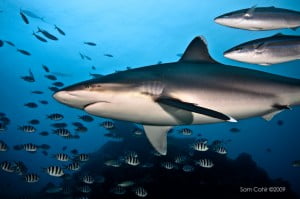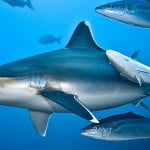Sharks (superorder Selachimorpha) are a type of fish with a full cartilaginous skeleton and a highly streamlined body. The earliest known sharks date from more than 420 million years ago.[1]
Since that time, sharks have diversified into 440 species, ranging in size from the small dwarf lanternshark, Etmopterus perryi, a deep sea species of only 17 centimetres (6.7 in) in length, to the whale shark, Rhincodon typus, the largest fish, which reaches approximately 12 metres (39 ft) and which feeds only on plankton, squid, and small fish by filter feeding. Sharks are found in all seas and are common down to depths of 2,000 metres (6,600 ft). They generally do not live infreshwater, with a few exceptions such as the bull shark and the river shark which can live both in seawater and freshwater.[2] They breathe through five to seven gill slits. Sharks have a covering of dermal denticles that protects their skin from damage and parasites, and improves their fluid dynamics so the shark can move faster. They have several sets of replaceable teeth.[3]
Well-known species such as the great white shark, tiger shark, blue shark, mako shark, and the hammerhead are apex predators, at the top of the underwater food chain. Their extraordinary skills as predators fascinate and frighten humans, even as their survival is under serious threat from fishing and other human activities
Behavior
 The classic view describes a solitary hunter, ranging the oceans in search of food. However, this applies to only a few species. Most live far more sedentary, benthic lives. Even solitary sharks meet for breeding or at rich hunting grounds, which may lead them to cover thousands of miles in a year.[47] Shark migration patterns may be even more complex than in birds, with many sharks covering entire ocean basins.
The classic view describes a solitary hunter, ranging the oceans in search of food. However, this applies to only a few species. Most live far more sedentary, benthic lives. Even solitary sharks meet for breeding or at rich hunting grounds, which may lead them to cover thousands of miles in a year.[47] Shark migration patterns may be even more complex than in birds, with many sharks covering entire ocean basins.
Sharks can be highly social, remaining in large schools. Sometimes more than 100 scalloped hammerheads congregate around seamounts and islands, e.g., in the Gulf of California.[17] Cross-species social hierarchies exist. For example, oceanic whitetip sharks dominate silky sharks of comparable size during feeding.[39]
When approached too closely some sharks perform a threat display. This usually consists of exaggerated swimming movements, and can vary in intensity according to the threat level.[48]
Speed
In general, sharks swim (“cruise”) at an average speed of 8 kilometres per hour (5.0 mph) but when feeding or attacking, the average shark can reach speeds upwards of 19 kilometres per hour (12 mph). The shortfin mako shark, the fastest shark and one of the fastest fish, can burst at speeds up to 50 kilometres per hour (31 mph).[49] The great white shark is also capable of speed bursts. These exceptions may be due to the warm-blooded, or homeothermic, nature of these sharks’ physiology.
 Intelligence
Intelligence
Contrary to the common wisdom that sharks are instinct-driven “eating machines”, recent studies have indicated that many species possess powerful problem-solving skills,social skills and curiosity. The brain- to body-mass ratios of sharks are similar to mammals and birds.[50] In 1987, near Smitswinkle Bay, South Africa, a group of up to sevengreat white sharks worked together to move a partially beached dead whale to deeper waters to feed.[51] Sharks can engage in playful activities. Porbeagle sharks have been seen repeatedly rolling in kelp and chasing an individual who trailed a piece of kelp behind it.[52]
Sleep
Some sharks can lie on the bottom while actively pumping water over their gills, but their eyes remain open and actively follow divers.[53] When a shark is resting, it does not use its nares, but rather its spiracles. If a shark tried to use its nares while resting on the ocean floor, it would “inhale” sand rather than water. Many scientists believe this is one of the reasons sharks have spiracles. The spiny dogfish‘s spinal cord, rather than its brain, coordinates swimming, so spiny dogfish can continue to swim while sleeping.[53] It is also possible that sharks sleep in a manner similar to dolphins,[53] one cerebral hemisphere at a time, thus maintaining some consciousness and cerebral activity at all times.
http://en.wikipedia.org/wiki/Shark#Behavior















